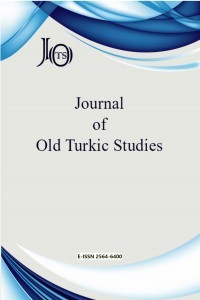Dede Korkut Kitabı’nın Dresden Yazmasında Geçen “Boy(u)n[ıy]ıla Kulag[ın] Almak” Deyimi Üzerine
The Book of Dede Qorqut is a corpus of epic stories that provide information about the language, history, administrative and social lifes, battles, beliefs, traditions and many more like that of the Oghuz people who have a nomadic lifestyle. Among the existing manuscripts, the most intense in terms of content is the Dresden manuscript, which contains an introduction and twelve stories. Various studies have been made on the content or the vocabulary of the manuscript. It is seen that idioms with stereotyped phrases are frequently used in the manuscript, which is a very rich resource in terms of vocabulary. In this study, the phrase boy(u)n[ıy]ıla qulaγ[ın] almaq in the second story of the Dresden manuscript with the title Salur Qazanuñ ėvi yaġmalanduġı boy[ı beyān ėder] will be explained with reference to the parallel examples and witnesses existing in the historical texts of Turkish.
Anahtar Kelimeler:
The Book of Dede Qorqut, Dresden manuscript, boynıyıla qulaγın almaq, idiom
On the Idiom Boy(u)n[ıy]ıla Qulaγ[ın] Almaq in the Dresden Manuscript of the Book of Dede Qorqut
The Book of Dede Qorqut is a corpus of epic stories that provide information about the language, history, administrative and social lifes, battles, beliefs, traditions and many more like that of the Oghuz people who have a nomadic lifestyle. Among the existing manuscripts, the most intense in terms of content is the Dresden manuscript, which contains an introduction and twelve stories. Various studies have been made on the content or the vocabulary of the manuscript. It is seen that idioms with stereotyped phrases are frequently used in the manuscript, which is a very rich resource in terms of vocabulary. In this study, the phrase boy(u)n[ıy]ıla qulaγ[ın] almaq in the second story of the Dresden manuscript with the title Salur Qazanuñ ėvi yaġmalanduġı boy[ı beyān ėder] will be explained with reference to the parallel examples and witnesses existing in the historical texts of Turkish.
___
- Ergin, M. (2011). Dede Korkut Kitabı I: Giriş-Metin-Tıpkıbasım. Ankara: Türk Dil Kurumu Yayınları.
- Gökyay, O. Ş. (2006). Dedem Korkudun Kitabı. İstanbul: Kabalcı.
- Kaçalin, M. S. (2017). Oğuzların Diliyle Dedem Korkudun Kitabı. Ankara: Türk Dil Kurumu Yayınları.
- Mirsultan, A. (2016). Kontinuität in der Phraseologie des Alt- und Neuuigurischen vom 14. bis zum 20. Jahrhundert. In Reckel, J. (Ed.), Central Asia Sources and Central Asia Research. 39, 121-137.
- Orucov, E. et al. (2006). Azǝrbaycan Dilinin İzahlı Lüğǝti I-IV. Bakı: Şerq-Qerb.
- Özçelik, S. (2016). Dede Korkut -Dresden Nüshası- Metin, Dizin II. Ankara: Türk Dil Kurumu Yayınları.
- Sertkaya, O. F. (2020). Dede Korkut Kitabı’nın Günbed Yazmasında Kaç Tane Boy (veya Boylama) Var? In Dede Korkut’un Günbed Yazması Üzerine Araştırmalar ve İncelemeler (pp. 161-165). İstanbul: Bilge Kültür-Sanat.
- Tezcan, S. (2018). Dede Korkut Oğuznameleri Üzerine Notlar. İstanbul: Yapı Kredi Yayınları.
- Tulu, S. (2020). Dede Korkut Oğuznâmesi -Boylar ve Soylamalar- Günümüz Türkçesine Sözlü Çevirisi. Dresden Nüshası ve Günbed-i Kâvus/Türkmensahra El Yazması Esasında. Ankara: Nobel Akademik Yayıncılık.
- Tulum, M. & Tulum, M. M. (2016). Dede Korkut-Oğuznameler-Oğuz Beylerinin Hikâyeleri. Ankara: Atatürk Kültür, Dil ve Tarih Yüksek Kurumu Atatürk Kültür Merkezi Başkanlığı.
- Yakup, A. et al. (1990). Uyġur Tiliniñ İzahliḳ Luġiti (A-P) I. Şincan: Milletler Neşriyatı.
- Yüce, N. (1988). Mukaddimetü’l-Edeb. Ḫvārizm Türkçesi ile Tercümeli Şuşter Nüshası. Giriş, Dil Özellikleri, Metin, İndeks. Ankara: Türk Dil Kurumu Yayınları.
- Yayın Aralığı: Yılda 2 Sayı
- Başlangıç: 2017
- Yayıncı: Erdem UÇAR
Sayıdaki Diğer Makaleler
Dede Korkut Kitabı’nın Dresden Yazmasında Geçen “Boy(u)n[ıy]ıla Kulag[ın] Almak” Deyimi Üzerine
Dağlık Altay Yazıtlarından Kuray I (A 4) Üzerinde Yeni Bir Okuma ve Anlamlandırma
Dede Korkut’un Yeni Kolaj Tarzı Yazması Hocali Molla’nın mıdır?
Additional Turkic and Tungusic Borrowings into Yukaghir VI
A Hunnic Word for Spoon: 留犁 Liuli
Tantrik Türk Budizmi’nde Cinsel Kucaklaşma Sembolü Yab Yum Üzerine
Hun Siyasî Sisteminde Akrabalık
